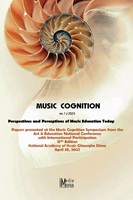The relationship between stylistic elements-vocal technique and emotionality in Tiberiu Brediceanu`s songs for voice and piano
The relationship between stylistic elements-vocal technique and emotionality in Tiberiu Brediceanu`s songs for voice and piano
Author(s): Cezara-Teodora DițăSubject(s): Customs / Folklore, Music, Cultural Anthropology / Ethnology, Culture and social structure , Sociology of Art, History of Art
Published by: MediaMusica
Keywords: romanian song; emotion; doina; emotionality; melodic line; rhythm;
Summary/Abstract: The eighty Doinas and Romanian folk songs of Tiberiu Brediceanu compose the miniature creation of the composer, these being authentic romanian songs, collected by he from different areas of the country, songs that later were transcribed and arranged. These are different from multiple point of view: tempo, measure, melodic line, rhythmic structure, dinamic ellements, agogic indications, relationship between vocal performer-accompanist pianist, but the emotions is a common point of all these, the emotion that they transmit to the public in the moment of musical performance. The emotion, according to the dictionaries represents an affective reaction, usually of medium intensity which takes place for a very short period of time, producing changes in the body`s activities. Bassically it mirrors a person`s attitude towards reality, attitude influenced by one or more internal/external factor. The emotion that a vocal performer conveys in the moment when interprets a musical work involves multiple factories: his state of mind, the temperament, his personality, creativity and last but not least, musical education. There doesn`t exist an universal classification of emotions, because they can be classified according to cultural context, possible target, life span, etc. There are eight primary emotions that can be grouped positively or negatively: joy-sadness, angerfear, trust-disgust, surprise-anticipation, all these can be combined, thus giving birth to other emotions. From all those emotions previously mentioned in the ten songbooks of Tiberiu Brediceanu, most often we encounter sadness caused by unshared love, children leaving/boyfriends going to war and loy – in those songs in which the love story between two young people is related, who feel the thrill of love for the first time. Also, the specific Romanian vocal gender which best conveys longing is doina, predominant in the songs harmonized by Tiberiu Brediceanu (Bălan, 1976, p. 14). Doina, was an important source of inspiration not just for Tiberiu Brediceanu, even for other composers, because its musical-structural elements (parlando singing, the melismatic melodic line, metric instability, different dynamics and agogic rubato) express directly, intens and deep a variety of ideas and feelings.
Journal: Cogniție Muzicală
- Issue Year: I/2023
- Issue No: 1
- Page Range: 75-81
- Page Count: 7
- Language: English

